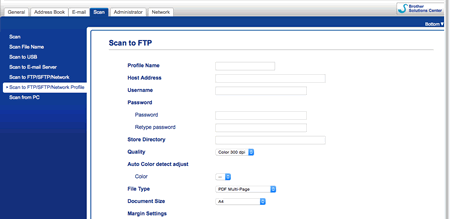ADS-2700W
FAQs & Troubleshooting |
Set up a Scan to FTP Profile
Set up a Scan to FTP Profile to scan and upload the scanned data directly to an FTP location.
We recommend Microsoft® Internet Explorer® 8/10/11 for Windows, and Safari 8.0 for Mac. Make sure that JavaScript and Cookies are always enabled in whichever browser you use. If a different web browser is used, make sure it is compatible with HTTP 1.0 and HTTP 1.1.
-
Start your web browser.
Type "http://machine's IP address" in your browser's address bar (where "machine's IP address" is the machine's IP address).
For example: http://192.168.1.2
If you have previously set a password, type it, and then click .
. - Click the Scan tab.
- Click the Scan to FTP/SFTP/Network menu in the left navigation bar.
- Select the FTP option, and then click Submit.
- Click the Scan to FTP/SFTP/Network Profile menu in the left navigation bar.
-
Select the profile you want to set up or change.

The Profile setting screen appears. -
In the Profile Name field, type a name for this server profile (up to 14 alphanumeric characters).
The machine will display this name on the LCD. - In the Host Address field, type the Host Address (for example: ftp.example.com; up to 64 characters) or the IP address (for example: 192.23.56.189), and type the path (up to 255 characters) to the folder on the FTP server where you want to send your scanned data. Do not type a slash symbol at the beginning of the path.
- In the Username field, type a user name (up to 32 characters) that has permission to write data to the FTP server.
- In the Password field, type the password (up to 33 characters) associated with the user name you entered in the Username field. Type the password again in the Retype password field.
- In the Store Directory field, type the path (up to 255 characters) to the folder on the FTP server where you want to send your scanned data. Do not type a slash symbol at the beginning of the path.
- Click the Quality drop-down list, and then select a quality setting. When Auto is selected, you can adjust the detection level of color from the Auto Color detect adjust drop-down list.
- Click the File Type drop-down list, and then select the file type you want to use for the scanned document.
- Click the Document Size drop-down list, and then select your document size from the list. This is necessary to make sure the scanned file is the correct size.
- In the Margin Settings, enter a value between -3 and 3 to add or remove a specific margin at the edge of the image.
- Click the File Size drop-down list, and then select your file size from the list.
- Select On from the Skip Blank Page option, to remove blank pages of the document from the scanning results.
- Click the Skip blank page sensitivity drop-down list, and then select a value between -5 and 5.
- Click the 2-sided Scan drop-down list.
- Click the Brightness drop-down list, and then select the brightness level.
- Click the Contrast drop-down list, and then select the contrast level.
- Select On from the Continuous Scan option to continue scanning.
- Set the Passive Mode option to off or on depending on your FTP server and network firewall configuration. The default setting is on. In most cases, this setting does not need to be changed.
- Change the Port Number setting used to access the FTP server. The default for this setting is port 21. In most cases, this setting does not need to be changed.
- Click Submit.
- You can set the scanned file name and file name style in the Scan File Name menu in the left navigation bar.
- Using the following characters: ?, /, \, ", :, <, >, |, or * may cause a sending error.